4
Shelby Moore
Introduction
Keywords
Global warming
Greenhouse gas
Industrialization
Fossil fuels
Learning Objectives
- Determine the causes of climate change
- Understand how greenhouse gases trap heat
- Evaluate the relationship between industrialization, fossil fuel use, and global warming
- Learn how climate change is affecting Earth’s environment, and what may be specifically affected in the future
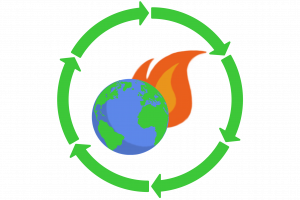
“Climate Change Global Warming” by Pete Linforth is in licensed by Pixabay
What is climate change? Climate change is the average change in conditions, including temperature and rainfall, in a region. In this situation, it is being used to describe condition changes all over earth.
This chapter covers effects climate change has had on Earth in the past as well as possible future impacts. It also covers the various causes of climate change and the specific roles each cause plays to alter the environment. The causes discussed include both natural factors, such as water vapor, and human activities, like fossil fuel use. Fossil fuels are nonrenewable resources present on earth, such as coal or natural gas, that formed from living organisms over a long period of time. They release carbon when they are burned. The carbon is then able to combine with oxygen present in the atmosphere, making carbon dioxide, a harmful greenhouse gas. So, the use of these fossil fuels is a big issue.
Recently, there has been a global temperature increase caused by industrialization, population growth, and other causes rooted in human activity. Too much change in global temperature could make the planet uninhabitable for many animals, including us. In order to slow the changes Earth is experiencing, the public must first be educated on the matter to understand its importance and learn what can be done.
Causes of Climate Change
Key Takeaways
There are many possible causes of climate change, but the focus of this section is on natural phenomena occurring on Earth and greenhouse gas emissions.
The causes of climate change have been studied for many years. Many scientists have created models showing greenhouse gas emissions and surface temperature changes or a number of other cause and effect relationships. They do this hoping to find a strong correlation, and determine which emissions impact climate and environmental changes most. These models comparing emission and results seen in the environment have allowed for improvements to be made and reduce the impact humans have on the environment.
Greenhouse Gases
Greenhouse gases are the main contributors to global warming. Figure 2 shows the mechanism of how greenhouse gases trap heat. As UV rays from the sun strike Earth, some are reflected back up into the atmosphere. Under normal circumstances, they would pass through the atmosphere and go back to space, but greenhouse gases prevent this. They disperse the reflected light and cause some to go back to Earth’s surface. This excess light heats the Earth. While this may seem as if it would always be a bad result, it is not. Greenhouse gases present in moderate amounts are crucial for maintaining the habitable conditions Earth has had for a lot of its history. They only become an issue when there are too many of them present in the atmosphere (Clarke, 2007).
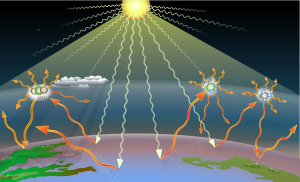
“Greenhouse Effect” by A loose necktie is licensed under CC BY-SA 4.0
There are five main greenhouse gases: carbon dioxide, methane, nitrous oxide, halocarbons, and ozone. Each of these gases has the potential to increase surface temperatures on Earth when present in excess (Karl et al., 2009).
Carbon Dioxide
Carbon dioxide is the most prevalent and well-known greenhouse gas. It is released with fossil fuel use. These fossil fuels are used for electricity generation, transportation, and a variety of other tasks needed for industries to function, so they are very commonly used, especially recently (Karl et al., 2009).
Methane Gas
Methane gas is released from livestock and during garbage decomposition in landfills. It is also a byproduct of bacteria that decompose organic matter in swamps and marshes. While it is not as prevalent in the atmosphere as carbon dioxide, its molecular structure causes it to have greater effects as a greenhouse gas. (Karl et al., 2009).
Nitrous Oxide
Nitrous oxide comes from fertilizer and fossil fuel use (Karl, 2009). Nitrous oxide also has the ability to deplete the protective ozone layer in Earth atmosphere by interacting at the molecular level. This ozone in the upper atmosphere protects the Earth’s surface from exposure to too much UV light from the sun (CCSP, 2008).
Halocarbons
Halocarbons, also called chlorofluorocarbons (CFCs), are also able to deplete ozone, but they do not have the heat trapping qualities the previous three gases have. They only deplete the necessary ozone in the upper atmosphere (Karl et al., 2009). Halocarbons are also the only greenhouse gases that do not occur naturally on Earth. They are emitted when polymer-based materials are melted and processed and during other industrial processes as well (Chigbo et al., 2016). Fortunately, international regulations have been put in place to limit the presence of these carbons in the atmosphere and protect the ozone layer (Karl et al., 2009).
Ozone
Unfortunately, too much ozone in the atmosphere can also cause problems. The excess ozone gathers in the lower atmosphere and acts as a greenhouse gas, reflecting light back to Earth’s surface (Karl et al., 2009).
Natural Phenomena
Natural contributors are things that happen on earth without any human intervention. These include volcanic eruptions, water vapor present in the atmosphere, and energy output by the sun.
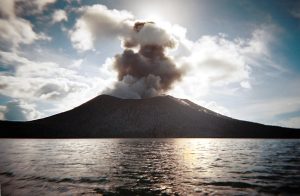
“Tavurvur Volcano Eruption 2010” by Dr Peter James Chisholm is licensed under CC BY-SA 4.0
Volcanic Eruptions
Volcanic eruptions release various gases and particles into the air when they occur. These can have a similar effect on the climate as greenhouse gases, trapping heat near Earth’s surface. However, they may also have the opposite effect as well. The dark particles, known as ash, released may prevent some UV rays from the surface of the earth at all.
Water Vapor
Water vapor is present in the form of clouds in the atmosphere. It is also classified as a greenhouse gas, despite it being naturally occurring, because certain aspects of the molecular structure allow it to have similar effects on the temperature as other greenhouse gases. The water particles are able to disperse light reflected off of Earth’s surface. Some waves travel out of the atmosphere but others are directed back to the surface, trapping it in the atmosphere and causing an increase in temperature (Karl et al. 2009).
Sun Energy Output
Energy output by the sun fluctuates over time. The fluctuations may cause increased or decreased temperatures on Earth depending on the amount of energy released. When solar output is stronger, more light and heat are reaching earth’s surface and the potential for that heat to be trapped is increased by greenhouse gases present in the atmosphere (Chigbo et al., 2016).
Societal Influences on Climate Change
Key Takeaways
Industrialization and human population growth contribute to the emission of greenhouse gases. Some countries, such as China and the United States have made higher contributions to greenhouse gas emissions due to their larger involvement with industrialization over time.
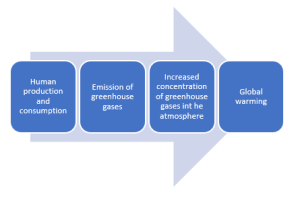
There are many social factors that have influenced climate change. Industrialization and general population growth have resulted in increased greenhouse gas emission and thus a warmer climate. This causational relationship is demonstrated in Figure 4. Human production and consumption include burning fossil fuels for electricity and heat, deforestation, fertilizer use, and production of CFCs (Bongaarts, 1992).
Industrialization is a large contributor to global warming. As nations moved from rural practices to industry, they began using more and more fossil fuels, which release greenhouse gases into the atmosphere. To date, approximately 80% of the carbon dioxide buildup present in the atmosphere is due to industrialized countries. Another important factor to consider is that many industrialized countries tend to have larger populations (Chigbo et al., 2016).
Population growth has also played a key role in global warming. As the world population increased, particularly in the period following World War II, fossil fuel and fertilizer use also grew. Urban development also became a large issue because of the increase in deforestation and fossil fuel burning transportation systems. Today, approximately 98% of carbon dioxide emissions and 24% of methane emissions are due to the tremendous population growth seen worldwide. This follows the chain of causation associated with global warming shown in Figure 4.
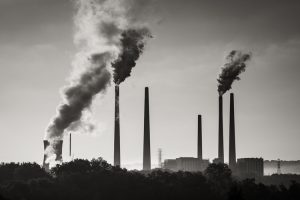
“Coal Fired Smoke Stacks” by Robert S. Donovan is licensed under CC BY 3.0
United States
The United States is the leading country in greenhouse gas emission per capita. Today, it accounts for approximately 40% of emission released by industrialized countries. This is mostly due to its heavy involvement in industrialization compared to other countries (Chigbo et al., 2016).
China
While China does not have as large an impact as the United States, it does still have a heavy carbon footprint. China has not had a long period of industrialization, but it does have a much larger population. Because they have more human activity releasing harmful gases, they are also large contributors in climate change.
The History and Impacts of Climate Change
Key Takeaways
Earth has experienced various changes in its climate throughout history, but recently, the climate has been experiencing warming. This warming has led to many environmental changes.
It is known that the Earth’s surface has been warming at a faster rate recently than it has for most of Earth’s history. This is due to the increase in human activity described in the previous sections. Most of the warming has occurred in the last two centuries. Between 1880 and 2012, the surface has warmed approximately 0.85 degree Celsius (IPCC, 2013)
A well-known period of warming occurred from 1900 to 1950, and it was known as the Early Twentieth Century Warming. This was the first occurrence of significant warming on Earth. Both natural and human contributions played a role in this warming period (Hegerl et al., 2018). While this is one of the most well known periods of warming, it is not the only one. Temperatures on Earth have been exponentially increasing throughout history, and this has led to many detrimental effects in the environment. One example being, arctic ice depletion.
Arctic Sea Ice Depletion
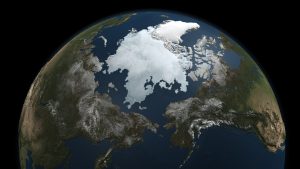
“A Snapshot of Sea Ice” by NASA Goddard Space Flight Center is licensed under CC BY 2.0
Many scientists believe Earth has entered a period of hiatus or slowdown in climate change due to decreased temperature observations by some large organizations. However, according to a group of scientists studying warming patterns in the Arctic, the arctic region was still experiencing a large degree of warming. Between the years 1998 and 2012, this region has had an average temperature increase of 0.755 degrees Celsius per decade.
The areas with the most warming were concentrated near the Eurasian continent due to the warming trends recently seen on this landmass. While this trend is not spread evenly across the region, it has led to significant ice depletion in the Arctic Sea (Huang et al., 2017).
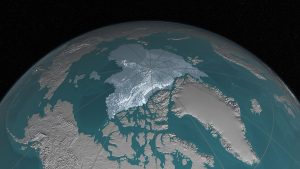
“Arctic Sea Ice Is Losing Its Bulwark Against Warming Summers” by NASA Goddard Space Flight Center is licensed under CC BY 2.0
Figures 6 and 7 show the decrease in ice present in the arctic region between 2010 and 2016. Even over this seemingly short period of time, a large portion of the ice has disappeared. This melting ice not only destroys natural habitats for animals, putting many species at risk of extinction, but it can also lead to other changes worldwide, including sea level rise.
Sea Level Rise
The observed sea level has risen with atmospheric temperature rise, and is predicted to continue increasing throughout the 21st century. The change in sea level is mostly due to water expansion. As the ocean heats up, thermal expansion occurs, raising the sea level. Another result of climate change that contributes to sea level rise is the melting of glaciers and ice sheets on land. As they heat up and melt, they can add a tremendous amount of water to oceans (IPCC, 2013). This land glacier and ice sheet mass loss combined with water expansion, has led to destruction of coastal habitats along with erosion and water contamination further inland.
Chapter Summary
- This portion of the chapter covers the causes of greenhouse gases including natural and human causation. It describes the mechanism of greenhouse gases and explains where they come from.
- It explains social influences that have impacted climate change. This includes the period of industrialization which drastically increased the use of fossil fuels. It also discusses how population growth can contribute to greenhouse gas emissions and provides examples of countries that have played a key role.
- The section discusses well-known periods of warming in the past and how the environment has changed as a result of climate change.
Review Questions
1. Which of the following is a greenhouse gas mentioned in the chapter?
a. Ozone
b. Benzene gas
c. Gasoline
d. Nitrogen
2. What is an example of a fossil fuel?
a. Bone
b. Oxygen
c. Coal
d. Wood
3. Why does burning fossil fuels increase greenhouse gas levels in the air?
a. Nitrous oxide is used in the process of burning them
b. They release carbon when they are burned, which then combines with oxygen
c. They produce methane gas
d. They release carbon dioxide when they are burned
4. Why are increased periods of industrialization correlated with surface temperature increase?
Answers
1-a, 2-c, 3-b, 4- Industrialization corresponds to an increase in fossil fuel use. By burning more fossil fuels, more greenhouse gases are released into the air, warming the surface of the Earth.
References
Bongaarts, J. (1992). Population Growth and Global Warming. Population and Development Review, 18(2), 299-319. doi:10.2307/1973681
CCSP, 2008: Trends in Emissions of Ozone-Depleting Substances, Ozone Layer Recovery, and Implications for Ultraviolet Radiation Exposure. A Report by the U.S. Climate Change Science Program and the Subcommittee on Global Change Research. [Ravishankara, A.R., M.J. Kurylo, and C.A. Ennis (eds.)]. Department of Commerce, NOAA’s National Climatic Data Center, Asheville, NC, 240 pp.
Chigbo A. Mgbemene, Chidozie C. Nnaji and Chekwubechukwu Nwozor, 2016. Industrialization and its Backlash: Focus on Climate Change and its Consequences. Journal of Environmental Science and Technology, 9: 301-316. 10.3923/jest.2016.301.316
Clarke, L., J. Edmonds, H. Jacoby, H. Pitcher, J. Reilly, R. Richels, 2007. Scenarios of Greenhouse Gas Emissions and Atmospheric Concentrations. Sub-report 2.1A of Synthesis and Assessment Product 2.1 by the U.S. Climate Change Science Program and the Subcommittee on Global Change Research. Department of Energy, Office of Biological & Environmental Research, Washington, DC., USA, 154 pp.
Hegerl, G. C., Brönnimann, S., Schurer, A., & Cowan, T. (2018). The early 20th century warming: Anomalies, causes, and consequences. Wiley Interdisciplinary Reviews, 9(4) http://dx.doi.org/10.1002/wcc.522
Huang, J., Zhang, X., Zhang, Q., Lin, Y., Hao, M., Luo, Y., Zhao, Z., Yao, Y., Chen, X., Wang, L., Nie, S., Yin, Y., Xu, Y., & Zhang, J. (2017). Recently amplified arctic warming has contributed to a continual global warming trend. Nature Climate Change, 7(12), 875-879. http://dx.doi.org/10.1038/s41558-017-0009-5
IPCC, 2013: Summary for Policymakers. In: Climate Change 2013: The Physical Science Basis. Contribution of Working Group I to the Fifth Assessment Report of the Intergovernmental Panel on Climate Change [Stocker, T.F., D. Qin, G.-K. Plattner, M. Tignor, S.K. Allen, J. Boschung, A. Nauels, Y. Xia, V. Bex and P.M. Midgley (eds.)]. Cambridge University Press, Cambridge, United Kingdom and New York, NY, USA.
Karl, T. R., Melillo, J. M., & Peterson, T. C. (Eds.). (2009). Global Climate Change Impacts in the United States. Cambridge University Press. https://downloads.globalchange.gov/usimpacts/pdfs/climate-impacts-report.pdf
